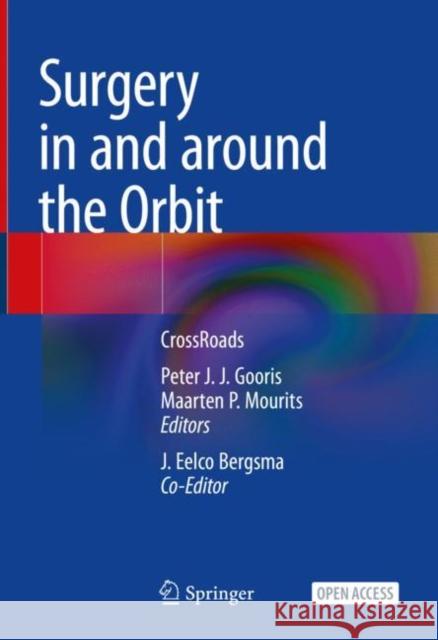Surgery in and around the Orbit: CrossRoads » książka
topmenu



Surgery in and around the Orbit: CrossRoads
ISBN-13: 9783031406966 / Twarda / 2023 / 306 str.
Kategorie BISAC:
Wydawca:
Springer International Publishing AG
ISBN-13:
9783031406966
Rok wydania:
2023
Ilość stron:
306
Wymiary:
25.4 x 17.8
Oprawa:
Twarda
Dedication (Mo)
About the Authors / Special Acknowledgments (G0/Mo)
Contents (Go)
Preface (Mo)
Introduction (Mo/Go)
I Anatomy of the orbital region (Co/Go/ Mo)
II Imaging of the orbit: “current concepts” (Wi)
III Ex – enophthalmus (Mo)
IV Diplopia (Je/Br)
V Traumatology
orbital fractures (Du/Go/Mo/Di)
1. diagnostics and treatment planning (Scr/(Ma/Du/Di/Go)
2. algorithm - flow sheet / treatment protocol (Du/Mo/Go/Ja/Je)
3. treatment of orbital fractures (Du/Go/Mo/Di/Be)
4. orbital fractures in children (Du/ Go/Mo)
5. emergency within the orbit (Mo/Du/Go/Di)
VI Graves’ disease
1. Introduction (Mo)
2. Diagnosis of Graves’ orbitopathy (Mo)
3. Etiology & pathogenesis (Wr)
4. Medical management of Graves’ orbitopathy (Wr)
5. orbital decompression surgery (Mo/Go)
VII Orbital soft tissue surgery (Mo)
VIII Infection in & around the orbit
Prof. Mourits was trained by Leo Koornneef and Wilmar Wiersinga at the AMC in Amsterdam. He completed his dissertation in 1990 on the topic "Management of Graves' Orbitopathy". He subsequently became a senior researcher at the Academic Centre of the University of Utrecht (1991-2004). After the Chernobyl catastrophe he was sent to Belarus by the Dutch government. From 2004-2018 he was then head of the Department of Ophthalmology at the AMC in Amsterdam, The Netherlands. Professor Mourits was President of the European Society for Plastic and Reconstructive Eye Surgery from 2007-2009. With his commitment to securing its funding, Mourits is considered one of the architects of the Eye Clinic Amsterdam (now Bergman Eyes Amsterdam). From 1990-2000 he was editor of the journal "Orbit", wrote more than 170 published registered papers and initiated and supervised more than 20 dissertations. He is currently a visiting professor in Cambodia and Tanzania and still practices in 'his' eye clinic.
Dr. Peter Gooris completed his studies at the Dental and Medical Faculty of the University Hospital of Groningen, The Netherlands, in 2002 with a dissertation on "Studies on the Management of Squamous Cell Carcinoma of the Lower lip". He completed his training as an Oral and Maxillofacial Surgeon from 1985 to 1989 at the University of Washington, Department of Oral and Maxillofacial Surgery, Seattle, USA. In 2000, he passed the European Board Examinations in Edinburgh, Scotland and earned his FEBOMFS. From 2004 to 2017 he was Director of the Training Programme for Oral and Maxillofacial Surgery in Breda in collaboration with the department at the University Hospital of Utrecht, The Netherlands. In 2004 he founded the Dutch multidisciplinary Graves' Orbitopathy Group at the Amphia Hospital Breda, The Netherlands, in collaboration with Professor Dr. MP Mourits. From 2013 - 2020 he worked at the Department of Oral and Maxillofacial Surgery at the University Hospital Amsterdam, The Netherlands. From 2012 until today he is Affiliate Professor at the Department of Oral and Maxillofacial Surgery at the University of Washington, Seattle, USA. He has contributed to about 50 scientific articles and one book chapter and has supervised 5 dissertations.
Dr. Eelco Bergsma obtained his dental and medical degree at the University of Groningen. At the same University he completed his thesis “Late Degradation Tissue Response of PLLA Osteosynthesis” in 1995. He trained as an Oral and Maxillofacial Surgeon at the University Medical Centre in Groningen (1996-2000). Since 2002 he is a staff member at the Department of Oral and Maxillofacial Surgery at the Amphia Hospital in Breda and since 2015 he is Director of the Oral and Maxillofacial Surgery Training Program in Breda in association with the department at the University Medical Centre Utrecht. He is a co-worker of the "Breda Graves Orbitopathy Group”. Bergsma is a board member of the Dutch Association of Oral and Maxillofacial Surgeons and was President of the Dutch Association of Oral Implantology (2009- 2013). He has contributed to more than 40 scientific papers.
This OpenAccess - textbook sheds new light on pathology in and around the orbit, which is typically an area where many medical disciplines overlap. Each physician brings a specific expertise, but the goal should be that the end result of all this input is much more than the sum of the parts. Collaboration, insight and overall knowledge of all parties involved are essential to achieve an optimal patient outcome.
Oral and Maxillofacial surgeons have traditionally focused on the bony parts of the orbit, but usually have limited knowledge of the intricacies of binocular single vision, and for the Ophthalmologist it may be the other way around. In the past, scientific articles were often written from a single point of view, resulting in tunnel vision for the physician. The multidisciplinary approach to the orbit leads to an improvement in treatment that should not be underestimated and from which the patient benefits immensely. But especially for the physician and the trainees, a multidisciplinary consultation is a real goldmine in which a lot can be gained. Not every medical problem needs to be tackled in a multidisciplinary framework, but problems around the eye socket often do.
At Amphia Hospital in Breda, the Netherlands, more than fifteen years ago, a collaboration between Oral and Maxillofacial Surgeons, Endocrinologists and Ophthalmologists was initiated, which has proven to be very fruitful. The main focus was on Graves' Orbitopathy and orbital fractures, but problems associated with these conditions were also frequently encountered.
For those who want to follow this example, or for those who are interested in both orbital surgery and ophthalmological orbital issues, this book could prove to be complementary.
1997-2026 DolnySlask.com Agencja Internetowa
Zobacz: Księgarnia Czeska | Wydawnictwo Książkowe Klimaty | Mapa strony | Lista autorów
KrainaKsiazek.PL - Księgarnia Internetowa
KrainaKsiazek.PL - Księgarnia Internetowa









